Forensic Analysis and Steganography Techniques: A Data Security Report
VerifiedAdded on 2023/06/11
|10
|2459
|269
Report
AI Summary
This report provides a forensic analysis of steganography techniques, focusing on data hiding within images. It details the process of using various tools to decode hidden messages, ultimately selecting S-tool as the most effective due to its simplicity. The analysis involves concealing a document within an image and using S-tool with a specific password to extract the hidden content, which turns out to be assignment instructions. The report covers the types of steganography, security measures, and encryption mechanisms used. It also discusses the systematic approach to image analysis using S-tool, including the algorithms used for masking data and the authentication process required to reveal the hidden text file. The findings highlight the effectiveness of steganography in hiding data existence and the importance of authentication in data protection.

Forensic analysis-Steganography techniques
Name
Institution
Professor
Course
Date
Name
Institution
Professor
Course
Date
Paraphrase This Document
Need a fresh take? Get an instant paraphrase of this document with our AI Paraphraser
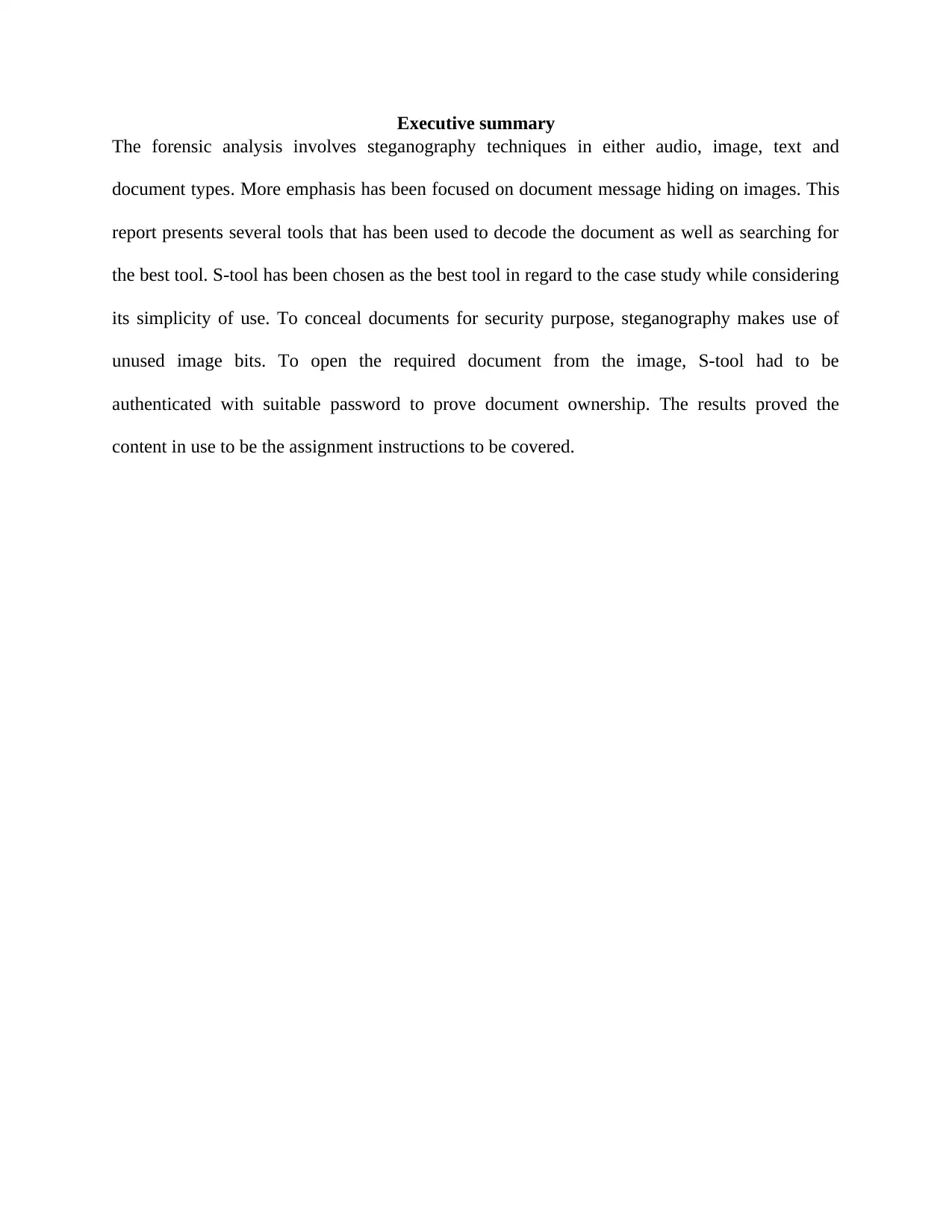
Executive summary
The forensic analysis involves steganography techniques in either audio, image, text and
document types. More emphasis has been focused on document message hiding on images. This
report presents several tools that has been used to decode the document as well as searching for
the best tool. S-tool has been chosen as the best tool in regard to the case study while considering
its simplicity of use. To conceal documents for security purpose, steganography makes use of
unused image bits. To open the required document from the image, S-tool had to be
authenticated with suitable password to prove document ownership. The results proved the
content in use to be the assignment instructions to be covered.
The forensic analysis involves steganography techniques in either audio, image, text and
document types. More emphasis has been focused on document message hiding on images. This
report presents several tools that has been used to decode the document as well as searching for
the best tool. S-tool has been chosen as the best tool in regard to the case study while considering
its simplicity of use. To conceal documents for security purpose, steganography makes use of
unused image bits. To open the required document from the image, S-tool had to be
authenticated with suitable password to prove document ownership. The results proved the
content in use to be the assignment instructions to be covered.
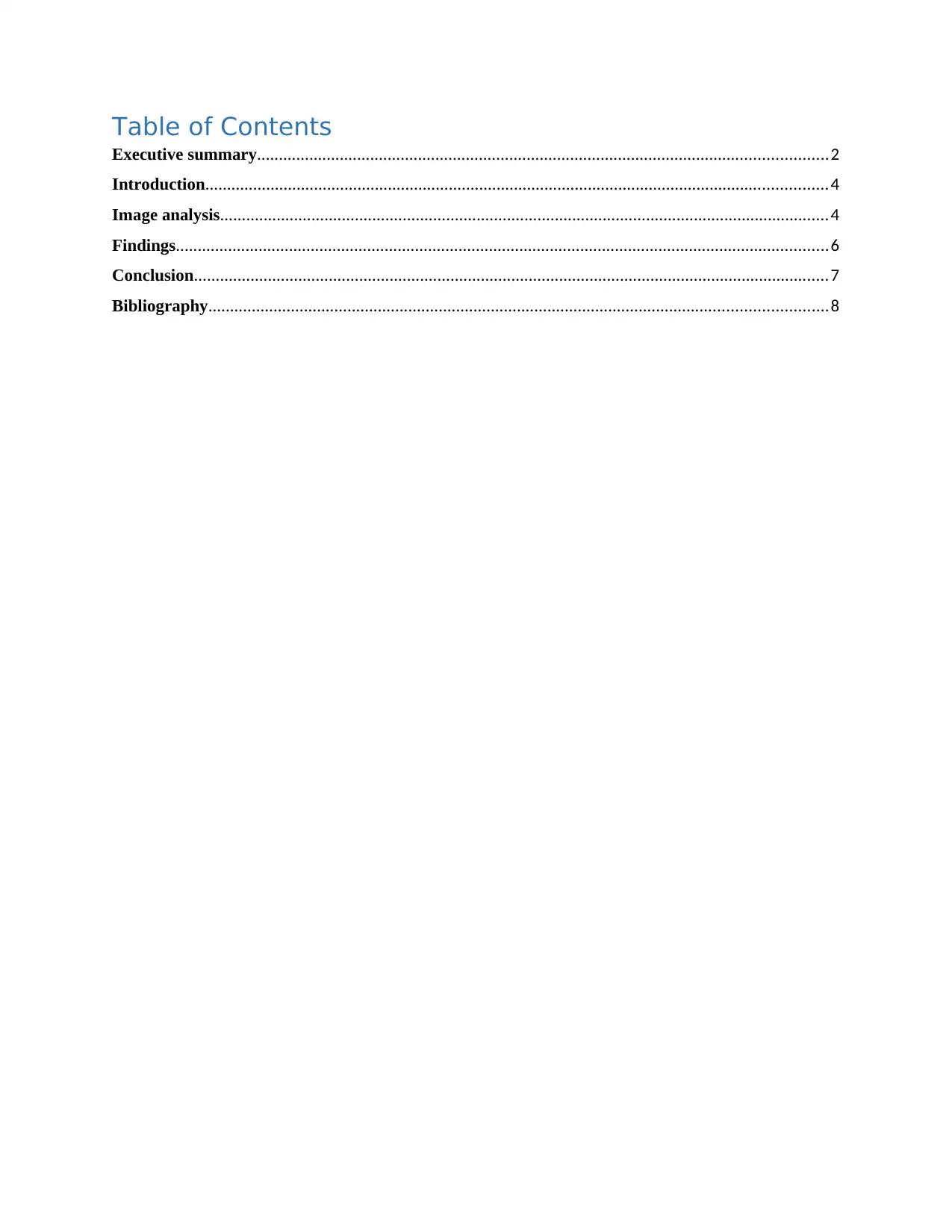
Table of Contents
Executive summary...................................................................................................................................2
Introduction...............................................................................................................................................4
Image analysis............................................................................................................................................4
Findings......................................................................................................................................................6
Conclusion..................................................................................................................................................7
Bibliography..............................................................................................................................................8
Executive summary...................................................................................................................................2
Introduction...............................................................................................................................................4
Image analysis............................................................................................................................................4
Findings......................................................................................................................................................6
Conclusion..................................................................................................................................................7
Bibliography..............................................................................................................................................8
⊘ This is a preview!⊘
Do you want full access?
Subscribe today to unlock all pages.

Trusted by 1+ million students worldwide
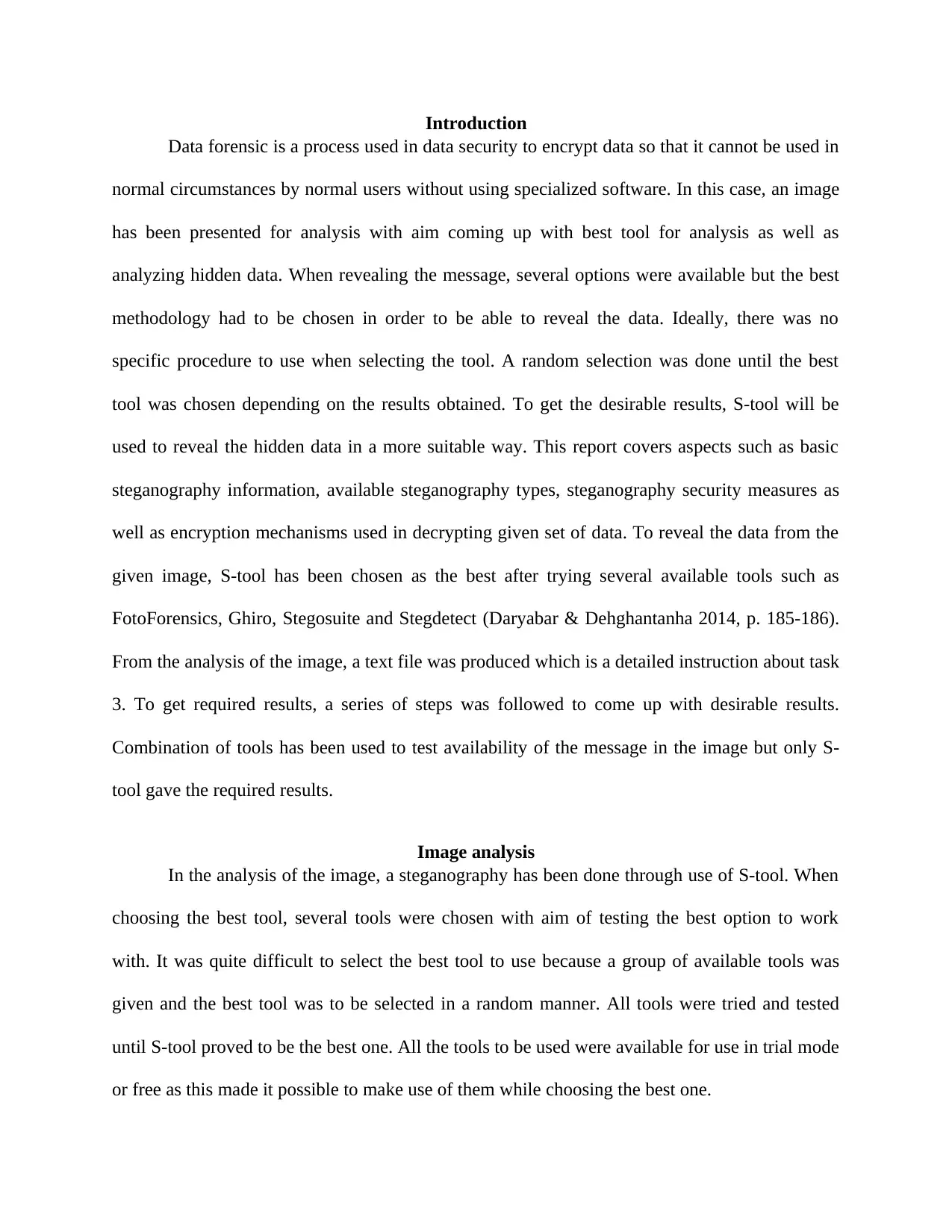
Introduction
Data forensic is a process used in data security to encrypt data so that it cannot be used in
normal circumstances by normal users without using specialized software. In this case, an image
has been presented for analysis with aim coming up with best tool for analysis as well as
analyzing hidden data. When revealing the message, several options were available but the best
methodology had to be chosen in order to be able to reveal the data. Ideally, there was no
specific procedure to use when selecting the tool. A random selection was done until the best
tool was chosen depending on the results obtained. To get the desirable results, S-tool will be
used to reveal the hidden data in a more suitable way. This report covers aspects such as basic
steganography information, available steganography types, steganography security measures as
well as encryption mechanisms used in decrypting given set of data. To reveal the data from the
given image, S-tool has been chosen as the best after trying several available tools such as
FotoForensics, Ghiro, Stegosuite and Stegdetect (Daryabar & Dehghantanha 2014, p. 185-186).
From the analysis of the image, a text file was produced which is a detailed instruction about task
3. To get required results, a series of steps was followed to come up with desirable results.
Combination of tools has been used to test availability of the message in the image but only S-
tool gave the required results.
Image analysis
In the analysis of the image, a steganography has been done through use of S-tool. When
choosing the best tool, several tools were chosen with aim of testing the best option to work
with. It was quite difficult to select the best tool to use because a group of available tools was
given and the best tool was to be selected in a random manner. All tools were tried and tested
until S-tool proved to be the best one. All the tools to be used were available for use in trial mode
or free as this made it possible to make use of them while choosing the best one.
Data forensic is a process used in data security to encrypt data so that it cannot be used in
normal circumstances by normal users without using specialized software. In this case, an image
has been presented for analysis with aim coming up with best tool for analysis as well as
analyzing hidden data. When revealing the message, several options were available but the best
methodology had to be chosen in order to be able to reveal the data. Ideally, there was no
specific procedure to use when selecting the tool. A random selection was done until the best
tool was chosen depending on the results obtained. To get the desirable results, S-tool will be
used to reveal the hidden data in a more suitable way. This report covers aspects such as basic
steganography information, available steganography types, steganography security measures as
well as encryption mechanisms used in decrypting given set of data. To reveal the data from the
given image, S-tool has been chosen as the best after trying several available tools such as
FotoForensics, Ghiro, Stegosuite and Stegdetect (Daryabar & Dehghantanha 2014, p. 185-186).
From the analysis of the image, a text file was produced which is a detailed instruction about task
3. To get required results, a series of steps was followed to come up with desirable results.
Combination of tools has been used to test availability of the message in the image but only S-
tool gave the required results.
Image analysis
In the analysis of the image, a steganography has been done through use of S-tool. When
choosing the best tool, several tools were chosen with aim of testing the best option to work
with. It was quite difficult to select the best tool to use because a group of available tools was
given and the best tool was to be selected in a random manner. All tools were tried and tested
until S-tool proved to be the best one. All the tools to be used were available for use in trial mode
or free as this made it possible to make use of them while choosing the best one.
Paraphrase This Document
Need a fresh take? Get an instant paraphrase of this document with our AI Paraphraser
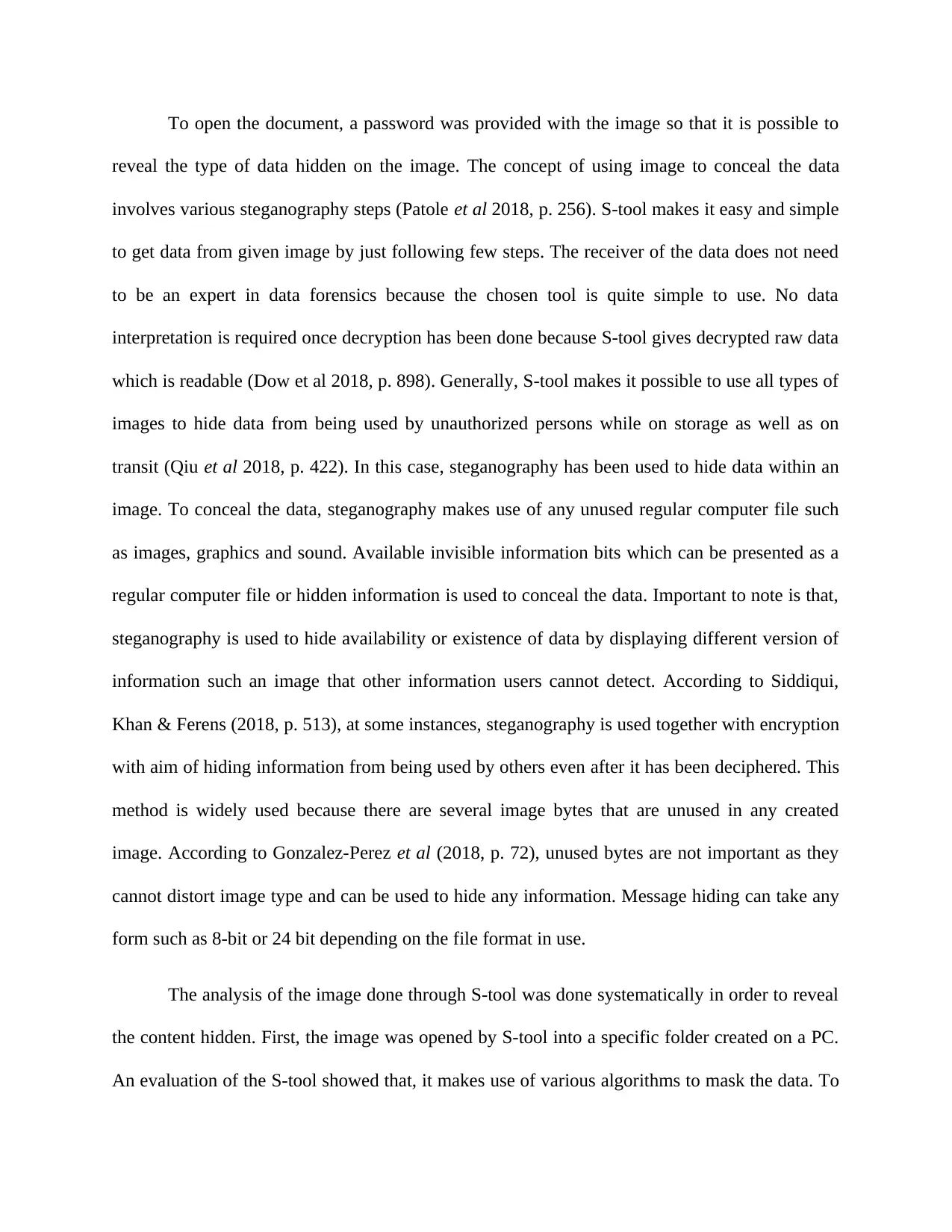
To open the document, a password was provided with the image so that it is possible to
reveal the type of data hidden on the image. The concept of using image to conceal the data
involves various steganography steps (Patole et al 2018, p. 256). S-tool makes it easy and simple
to get data from given image by just following few steps. The receiver of the data does not need
to be an expert in data forensics because the chosen tool is quite simple to use. No data
interpretation is required once decryption has been done because S-tool gives decrypted raw data
which is readable (Dow et al 2018, p. 898). Generally, S-tool makes it possible to use all types of
images to hide data from being used by unauthorized persons while on storage as well as on
transit (Qiu et al 2018, p. 422). In this case, steganography has been used to hide data within an
image. To conceal the data, steganography makes use of any unused regular computer file such
as images, graphics and sound. Available invisible information bits which can be presented as a
regular computer file or hidden information is used to conceal the data. Important to note is that,
steganography is used to hide availability or existence of data by displaying different version of
information such an image that other information users cannot detect. According to Siddiqui,
Khan & Ferens (2018, p. 513), at some instances, steganography is used together with encryption
with aim of hiding information from being used by others even after it has been deciphered. This
method is widely used because there are several image bytes that are unused in any created
image. According to Gonzalez-Perez et al (2018, p. 72), unused bytes are not important as they
cannot distort image type and can be used to hide any information. Message hiding can take any
form such as 8-bit or 24 bit depending on the file format in use.
The analysis of the image done through S-tool was done systematically in order to reveal
the content hidden. First, the image was opened by S-tool into a specific folder created on a PC.
An evaluation of the S-tool showed that, it makes use of various algorithms to mask the data. To
reveal the type of data hidden on the image. The concept of using image to conceal the data
involves various steganography steps (Patole et al 2018, p. 256). S-tool makes it easy and simple
to get data from given image by just following few steps. The receiver of the data does not need
to be an expert in data forensics because the chosen tool is quite simple to use. No data
interpretation is required once decryption has been done because S-tool gives decrypted raw data
which is readable (Dow et al 2018, p. 898). Generally, S-tool makes it possible to use all types of
images to hide data from being used by unauthorized persons while on storage as well as on
transit (Qiu et al 2018, p. 422). In this case, steganography has been used to hide data within an
image. To conceal the data, steganography makes use of any unused regular computer file such
as images, graphics and sound. Available invisible information bits which can be presented as a
regular computer file or hidden information is used to conceal the data. Important to note is that,
steganography is used to hide availability or existence of data by displaying different version of
information such an image that other information users cannot detect. According to Siddiqui,
Khan & Ferens (2018, p. 513), at some instances, steganography is used together with encryption
with aim of hiding information from being used by others even after it has been deciphered. This
method is widely used because there are several image bytes that are unused in any created
image. According to Gonzalez-Perez et al (2018, p. 72), unused bytes are not important as they
cannot distort image type and can be used to hide any information. Message hiding can take any
form such as 8-bit or 24 bit depending on the file format in use.
The analysis of the image done through S-tool was done systematically in order to reveal
the content hidden. First, the image was opened by S-tool into a specific folder created on a PC.
An evaluation of the S-tool showed that, it makes use of various algorithms to mask the data. To
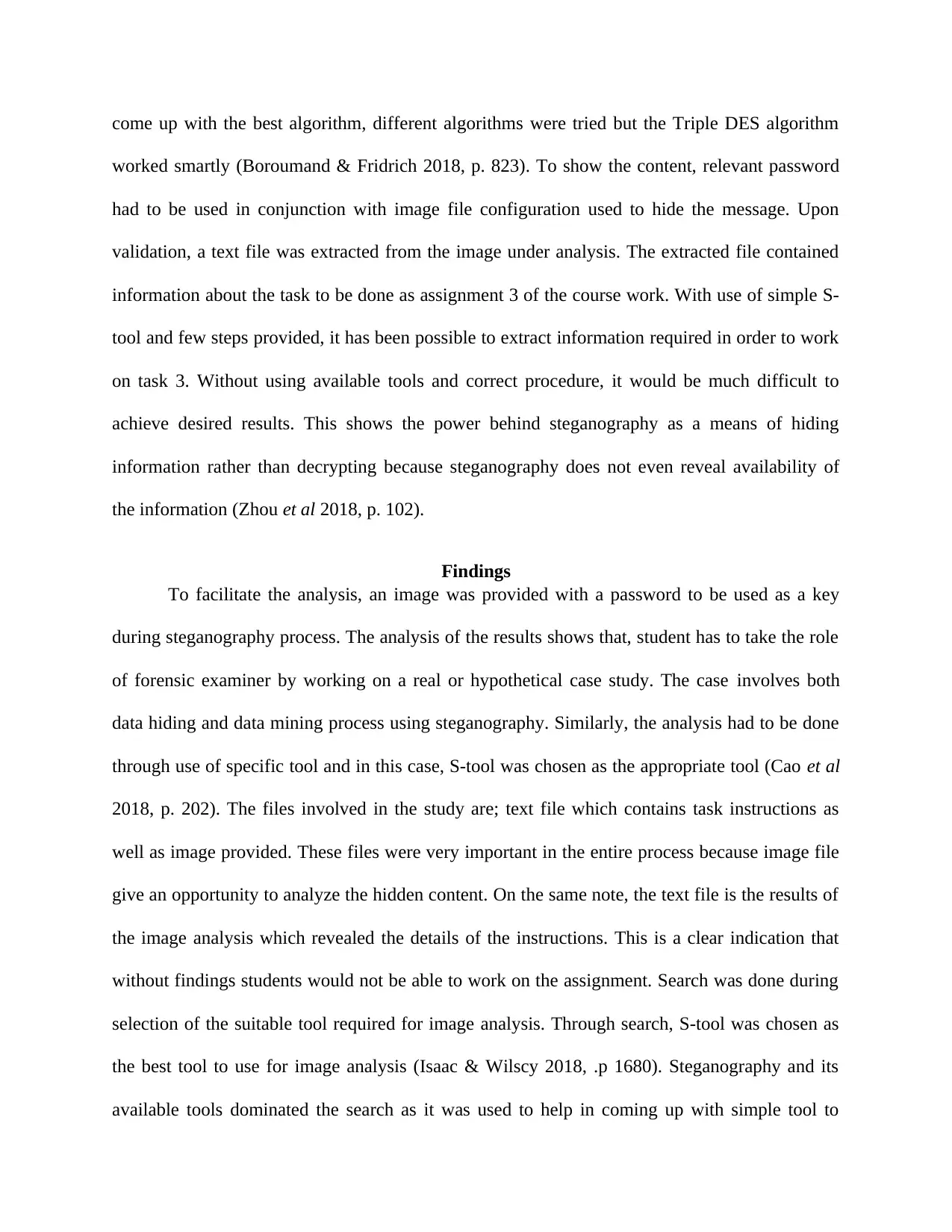
come up with the best algorithm, different algorithms were tried but the Triple DES algorithm
worked smartly (Boroumand & Fridrich 2018, p. 823). To show the content, relevant password
had to be used in conjunction with image file configuration used to hide the message. Upon
validation, a text file was extracted from the image under analysis. The extracted file contained
information about the task to be done as assignment 3 of the course work. With use of simple S-
tool and few steps provided, it has been possible to extract information required in order to work
on task 3. Without using available tools and correct procedure, it would be much difficult to
achieve desired results. This shows the power behind steganography as a means of hiding
information rather than decrypting because steganography does not even reveal availability of
the information (Zhou et al 2018, p. 102).
Findings
To facilitate the analysis, an image was provided with a password to be used as a key
during steganography process. The analysis of the results shows that, student has to take the role
of forensic examiner by working on a real or hypothetical case study. The case involves both
data hiding and data mining process using steganography. Similarly, the analysis had to be done
through use of specific tool and in this case, S-tool was chosen as the appropriate tool (Cao et al
2018, p. 202). The files involved in the study are; text file which contains task instructions as
well as image provided. These files were very important in the entire process because image file
give an opportunity to analyze the hidden content. On the same note, the text file is the results of
the image analysis which revealed the details of the instructions. This is a clear indication that
without findings students would not be able to work on the assignment. Search was done during
selection of the suitable tool required for image analysis. Through search, S-tool was chosen as
the best tool to use for image analysis (Isaac & Wilscy 2018, .p 1680). Steganography and its
available tools dominated the search as it was used to help in coming up with simple tool to
worked smartly (Boroumand & Fridrich 2018, p. 823). To show the content, relevant password
had to be used in conjunction with image file configuration used to hide the message. Upon
validation, a text file was extracted from the image under analysis. The extracted file contained
information about the task to be done as assignment 3 of the course work. With use of simple S-
tool and few steps provided, it has been possible to extract information required in order to work
on task 3. Without using available tools and correct procedure, it would be much difficult to
achieve desired results. This shows the power behind steganography as a means of hiding
information rather than decrypting because steganography does not even reveal availability of
the information (Zhou et al 2018, p. 102).
Findings
To facilitate the analysis, an image was provided with a password to be used as a key
during steganography process. The analysis of the results shows that, student has to take the role
of forensic examiner by working on a real or hypothetical case study. The case involves both
data hiding and data mining process using steganography. Similarly, the analysis had to be done
through use of specific tool and in this case, S-tool was chosen as the appropriate tool (Cao et al
2018, p. 202). The files involved in the study are; text file which contains task instructions as
well as image provided. These files were very important in the entire process because image file
give an opportunity to analyze the hidden content. On the same note, the text file is the results of
the image analysis which revealed the details of the instructions. This is a clear indication that
without findings students would not be able to work on the assignment. Search was done during
selection of the suitable tool required for image analysis. Through search, S-tool was chosen as
the best tool to use for image analysis (Isaac & Wilscy 2018, .p 1680). Steganography and its
available tools dominated the search as it was used to help in coming up with simple tool to
⊘ This is a preview!⊘
Do you want full access?
Subscribe today to unlock all pages.

Trusted by 1+ million students worldwide
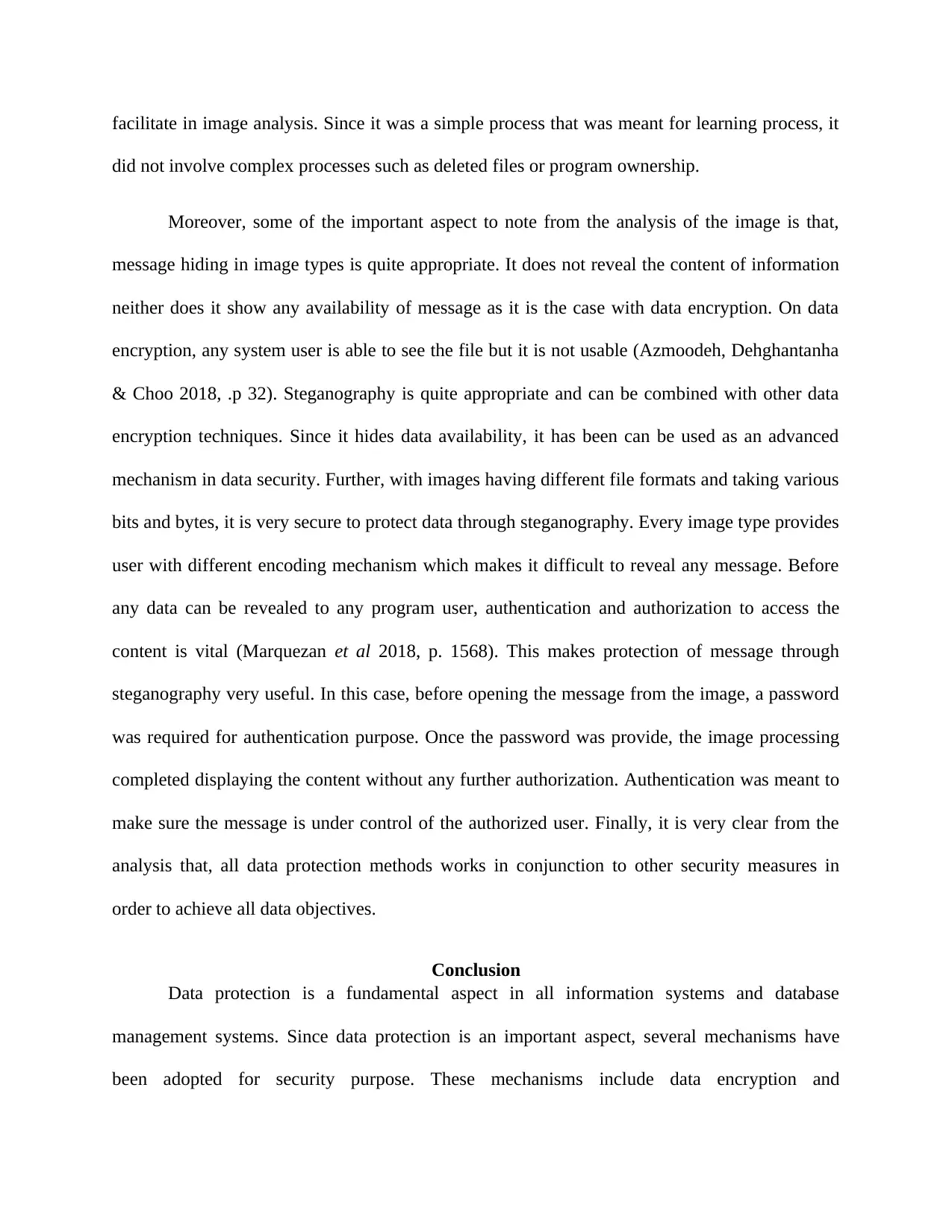
facilitate in image analysis. Since it was a simple process that was meant for learning process, it
did not involve complex processes such as deleted files or program ownership.
Moreover, some of the important aspect to note from the analysis of the image is that,
message hiding in image types is quite appropriate. It does not reveal the content of information
neither does it show any availability of message as it is the case with data encryption. On data
encryption, any system user is able to see the file but it is not usable (Azmoodeh, Dehghantanha
& Choo 2018, .p 32). Steganography is quite appropriate and can be combined with other data
encryption techniques. Since it hides data availability, it has been can be used as an advanced
mechanism in data security. Further, with images having different file formats and taking various
bits and bytes, it is very secure to protect data through steganography. Every image type provides
user with different encoding mechanism which makes it difficult to reveal any message. Before
any data can be revealed to any program user, authentication and authorization to access the
content is vital (Marquezan et al 2018, p. 1568). This makes protection of message through
steganography very useful. In this case, before opening the message from the image, a password
was required for authentication purpose. Once the password was provide, the image processing
completed displaying the content without any further authorization. Authentication was meant to
make sure the message is under control of the authorized user. Finally, it is very clear from the
analysis that, all data protection methods works in conjunction to other security measures in
order to achieve all data objectives.
Conclusion
Data protection is a fundamental aspect in all information systems and database
management systems. Since data protection is an important aspect, several mechanisms have
been adopted for security purpose. These mechanisms include data encryption and
did not involve complex processes such as deleted files or program ownership.
Moreover, some of the important aspect to note from the analysis of the image is that,
message hiding in image types is quite appropriate. It does not reveal the content of information
neither does it show any availability of message as it is the case with data encryption. On data
encryption, any system user is able to see the file but it is not usable (Azmoodeh, Dehghantanha
& Choo 2018, .p 32). Steganography is quite appropriate and can be combined with other data
encryption techniques. Since it hides data availability, it has been can be used as an advanced
mechanism in data security. Further, with images having different file formats and taking various
bits and bytes, it is very secure to protect data through steganography. Every image type provides
user with different encoding mechanism which makes it difficult to reveal any message. Before
any data can be revealed to any program user, authentication and authorization to access the
content is vital (Marquezan et al 2018, p. 1568). This makes protection of message through
steganography very useful. In this case, before opening the message from the image, a password
was required for authentication purpose. Once the password was provide, the image processing
completed displaying the content without any further authorization. Authentication was meant to
make sure the message is under control of the authorized user. Finally, it is very clear from the
analysis that, all data protection methods works in conjunction to other security measures in
order to achieve all data objectives.
Conclusion
Data protection is a fundamental aspect in all information systems and database
management systems. Since data protection is an important aspect, several mechanisms have
been adopted for security purpose. These mechanisms include data encryption and
Paraphrase This Document
Need a fresh take? Get an instant paraphrase of this document with our AI Paraphraser
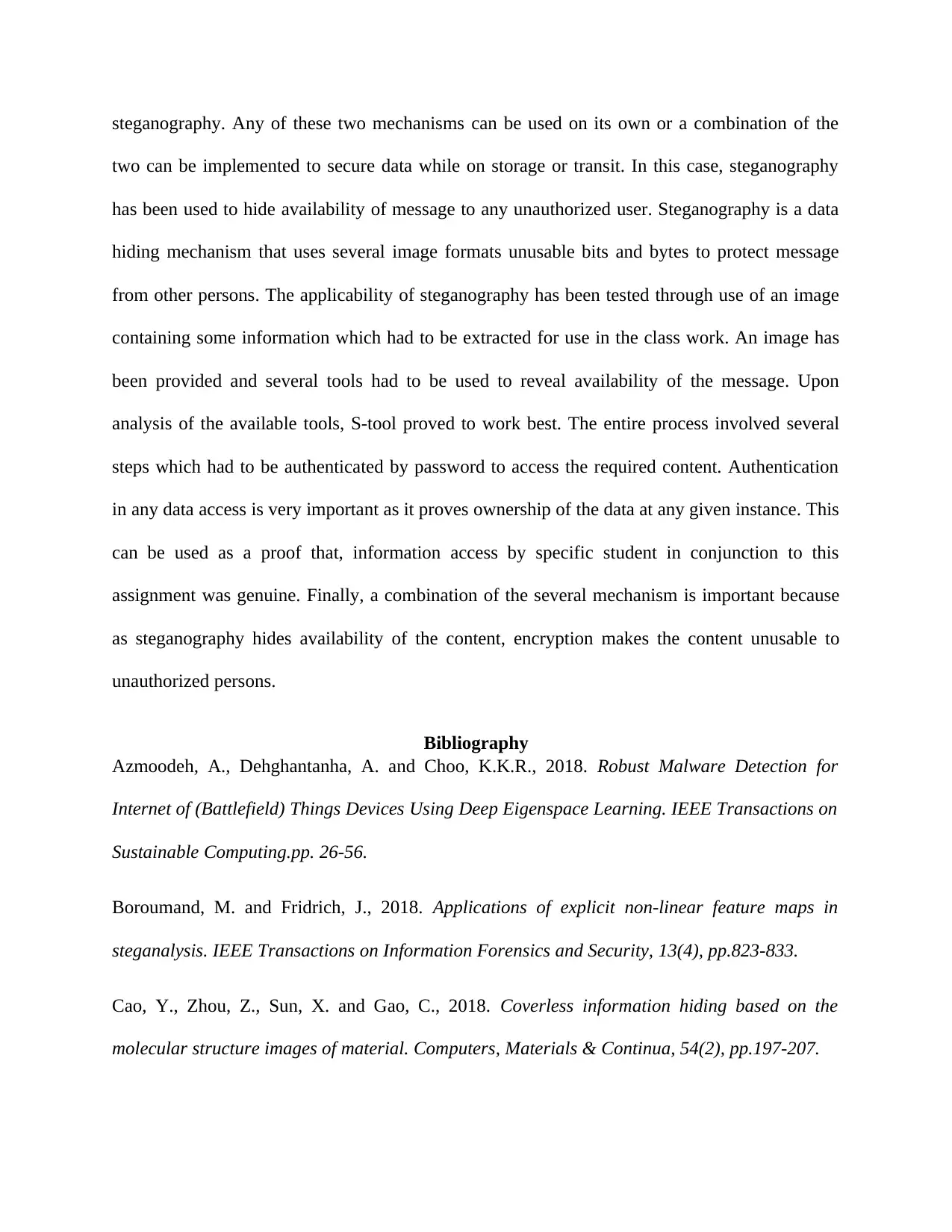
steganography. Any of these two mechanisms can be used on its own or a combination of the
two can be implemented to secure data while on storage or transit. In this case, steganography
has been used to hide availability of message to any unauthorized user. Steganography is a data
hiding mechanism that uses several image formats unusable bits and bytes to protect message
from other persons. The applicability of steganography has been tested through use of an image
containing some information which had to be extracted for use in the class work. An image has
been provided and several tools had to be used to reveal availability of the message. Upon
analysis of the available tools, S-tool proved to work best. The entire process involved several
steps which had to be authenticated by password to access the required content. Authentication
in any data access is very important as it proves ownership of the data at any given instance. This
can be used as a proof that, information access by specific student in conjunction to this
assignment was genuine. Finally, a combination of the several mechanism is important because
as steganography hides availability of the content, encryption makes the content unusable to
unauthorized persons.
Bibliography
Azmoodeh, A., Dehghantanha, A. and Choo, K.K.R., 2018. Robust Malware Detection for
Internet of (Battlefield) Things Devices Using Deep Eigenspace Learning. IEEE Transactions on
Sustainable Computing.pp. 26-56.
Boroumand, M. and Fridrich, J., 2018. Applications of explicit non-linear feature maps in
steganalysis. IEEE Transactions on Information Forensics and Security, 13(4), pp.823-833.
Cao, Y., Zhou, Z., Sun, X. and Gao, C., 2018. Coverless information hiding based on the
molecular structure images of material. Computers, Materials & Continua, 54(2), pp.197-207.
two can be implemented to secure data while on storage or transit. In this case, steganography
has been used to hide availability of message to any unauthorized user. Steganography is a data
hiding mechanism that uses several image formats unusable bits and bytes to protect message
from other persons. The applicability of steganography has been tested through use of an image
containing some information which had to be extracted for use in the class work. An image has
been provided and several tools had to be used to reveal availability of the message. Upon
analysis of the available tools, S-tool proved to work best. The entire process involved several
steps which had to be authenticated by password to access the required content. Authentication
in any data access is very important as it proves ownership of the data at any given instance. This
can be used as a proof that, information access by specific student in conjunction to this
assignment was genuine. Finally, a combination of the several mechanism is important because
as steganography hides availability of the content, encryption makes the content unusable to
unauthorized persons.
Bibliography
Azmoodeh, A., Dehghantanha, A. and Choo, K.K.R., 2018. Robust Malware Detection for
Internet of (Battlefield) Things Devices Using Deep Eigenspace Learning. IEEE Transactions on
Sustainable Computing.pp. 26-56.
Boroumand, M. and Fridrich, J., 2018. Applications of explicit non-linear feature maps in
steganalysis. IEEE Transactions on Information Forensics and Security, 13(4), pp.823-833.
Cao, Y., Zhou, Z., Sun, X. and Gao, C., 2018. Coverless information hiding based on the
molecular structure images of material. Computers, Materials & Continua, 54(2), pp.197-207.
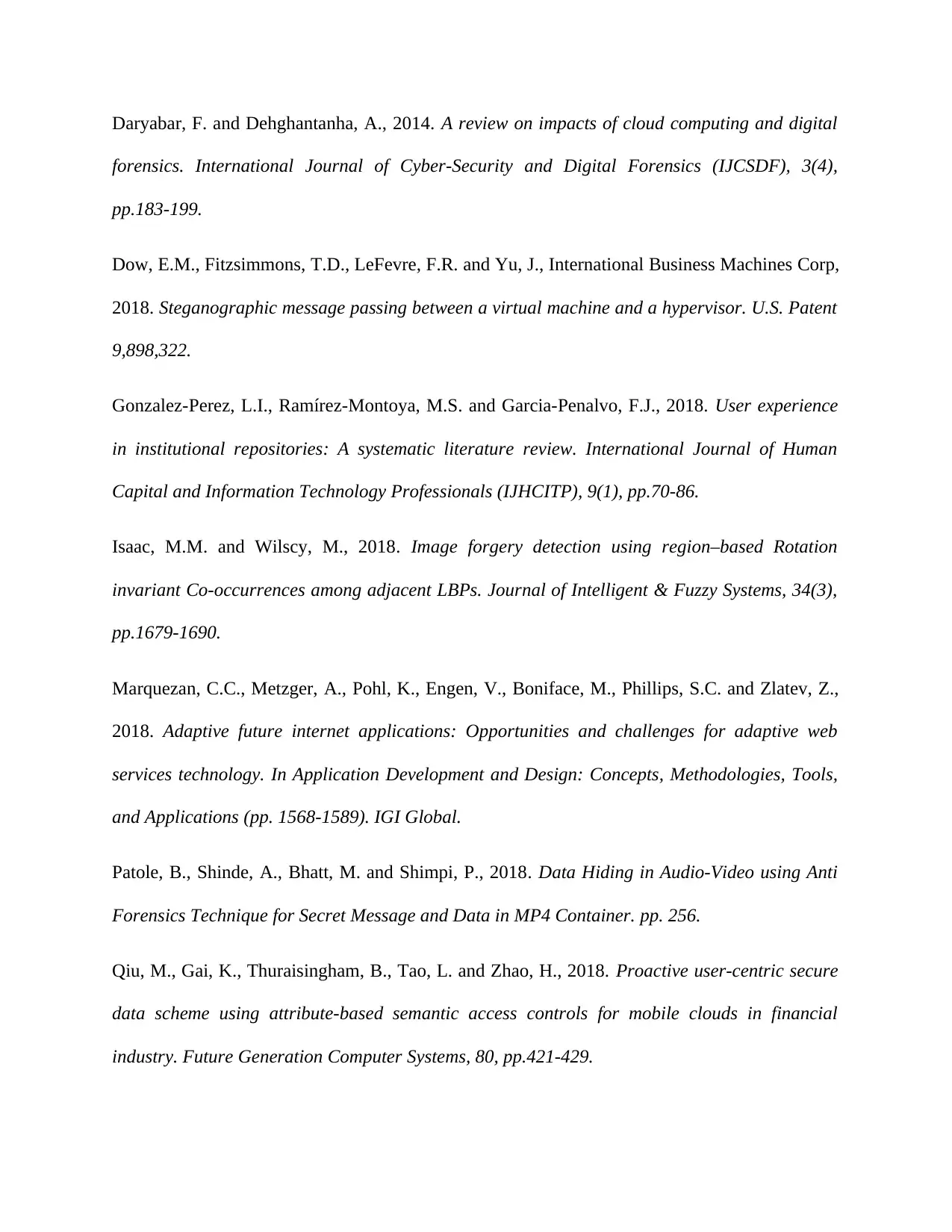
Daryabar, F. and Dehghantanha, A., 2014. A review on impacts of cloud computing and digital
forensics. International Journal of Cyber-Security and Digital Forensics (IJCSDF), 3(4),
pp.183-199.
Dow, E.M., Fitzsimmons, T.D., LeFevre, F.R. and Yu, J., International Business Machines Corp,
2018. Steganographic message passing between a virtual machine and a hypervisor. U.S. Patent
9,898,322.
Gonzalez-Perez, L.I., Ramírez-Montoya, M.S. and Garcia-Penalvo, F.J., 2018. User experience
in institutional repositories: A systematic literature review. International Journal of Human
Capital and Information Technology Professionals (IJHCITP), 9(1), pp.70-86.
Isaac, M.M. and Wilscy, M., 2018. Image forgery detection using region–based Rotation
invariant Co-occurrences among adjacent LBPs. Journal of Intelligent & Fuzzy Systems, 34(3),
pp.1679-1690.
Marquezan, C.C., Metzger, A., Pohl, K., Engen, V., Boniface, M., Phillips, S.C. and Zlatev, Z.,
2018. Adaptive future internet applications: Opportunities and challenges for adaptive web
services technology. In Application Development and Design: Concepts, Methodologies, Tools,
and Applications (pp. 1568-1589). IGI Global.
Patole, B., Shinde, A., Bhatt, M. and Shimpi, P., 2018. Data Hiding in Audio-Video using Anti
Forensics Technique for Secret Message and Data in MP4 Container. pp. 256.
Qiu, M., Gai, K., Thuraisingham, B., Tao, L. and Zhao, H., 2018. Proactive user-centric secure
data scheme using attribute-based semantic access controls for mobile clouds in financial
industry. Future Generation Computer Systems, 80, pp.421-429.
forensics. International Journal of Cyber-Security and Digital Forensics (IJCSDF), 3(4),
pp.183-199.
Dow, E.M., Fitzsimmons, T.D., LeFevre, F.R. and Yu, J., International Business Machines Corp,
2018. Steganographic message passing between a virtual machine and a hypervisor. U.S. Patent
9,898,322.
Gonzalez-Perez, L.I., Ramírez-Montoya, M.S. and Garcia-Penalvo, F.J., 2018. User experience
in institutional repositories: A systematic literature review. International Journal of Human
Capital and Information Technology Professionals (IJHCITP), 9(1), pp.70-86.
Isaac, M.M. and Wilscy, M., 2018. Image forgery detection using region–based Rotation
invariant Co-occurrences among adjacent LBPs. Journal of Intelligent & Fuzzy Systems, 34(3),
pp.1679-1690.
Marquezan, C.C., Metzger, A., Pohl, K., Engen, V., Boniface, M., Phillips, S.C. and Zlatev, Z.,
2018. Adaptive future internet applications: Opportunities and challenges for adaptive web
services technology. In Application Development and Design: Concepts, Methodologies, Tools,
and Applications (pp. 1568-1589). IGI Global.
Patole, B., Shinde, A., Bhatt, M. and Shimpi, P., 2018. Data Hiding in Audio-Video using Anti
Forensics Technique for Secret Message and Data in MP4 Container. pp. 256.
Qiu, M., Gai, K., Thuraisingham, B., Tao, L. and Zhao, H., 2018. Proactive user-centric secure
data scheme using attribute-based semantic access controls for mobile clouds in financial
industry. Future Generation Computer Systems, 80, pp.421-429.
⊘ This is a preview!⊘
Do you want full access?
Subscribe today to unlock all pages.

Trusted by 1+ million students worldwide
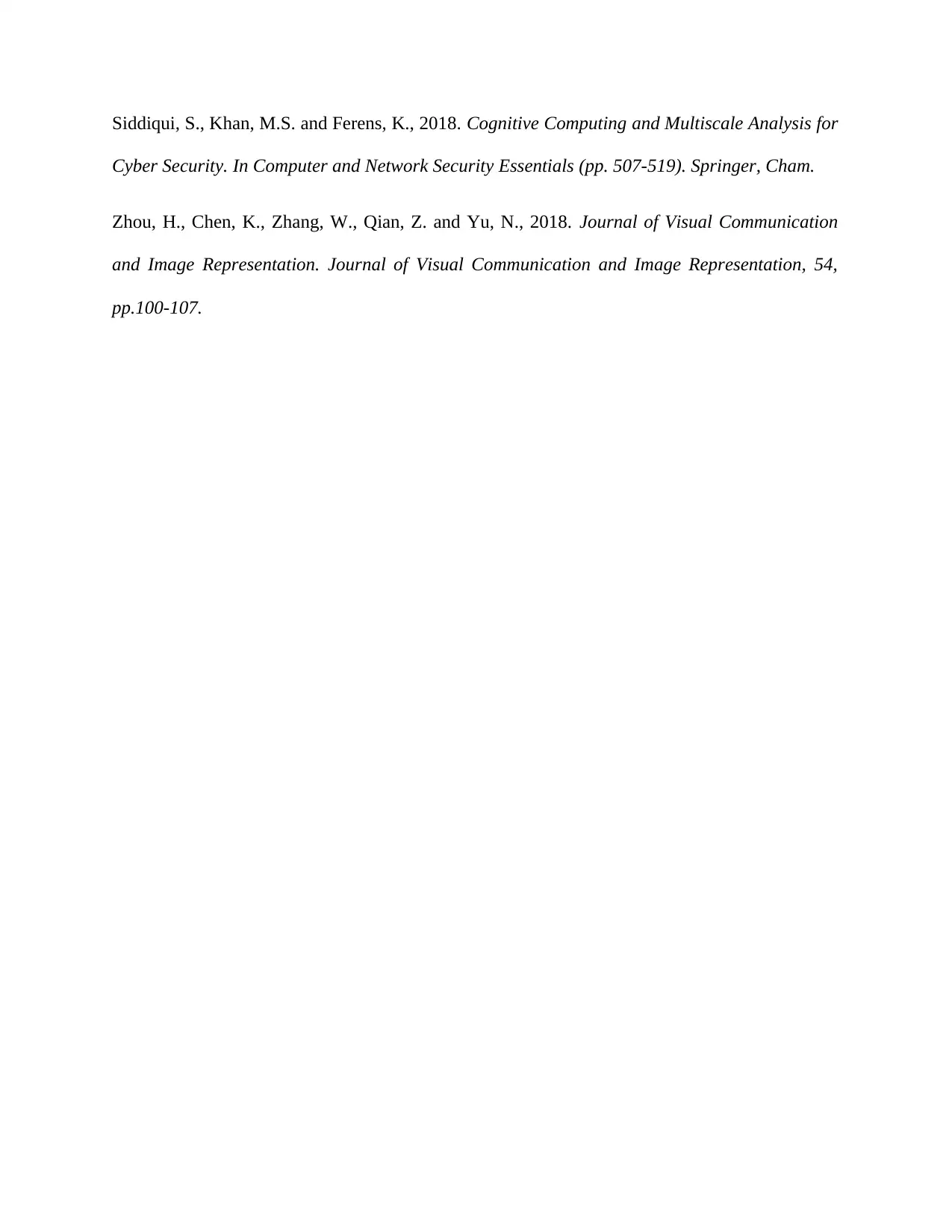
Siddiqui, S., Khan, M.S. and Ferens, K., 2018. Cognitive Computing and Multiscale Analysis for
Cyber Security. In Computer and Network Security Essentials (pp. 507-519). Springer, Cham.
Zhou, H., Chen, K., Zhang, W., Qian, Z. and Yu, N., 2018. Journal of Visual Communication
and Image Representation. Journal of Visual Communication and Image Representation, 54,
pp.100-107.
Cyber Security. In Computer and Network Security Essentials (pp. 507-519). Springer, Cham.
Zhou, H., Chen, K., Zhang, W., Qian, Z. and Yu, N., 2018. Journal of Visual Communication
and Image Representation. Journal of Visual Communication and Image Representation, 54,
pp.100-107.
1 out of 10
Related Documents
Your All-in-One AI-Powered Toolkit for Academic Success.
+13062052269
info@desklib.com
Available 24*7 on WhatsApp / Email
![[object Object]](/_next/static/media/star-bottom.7253800d.svg)
Unlock your academic potential
Copyright © 2020–2025 A2Z Services. All Rights Reserved. Developed and managed by ZUCOL.





